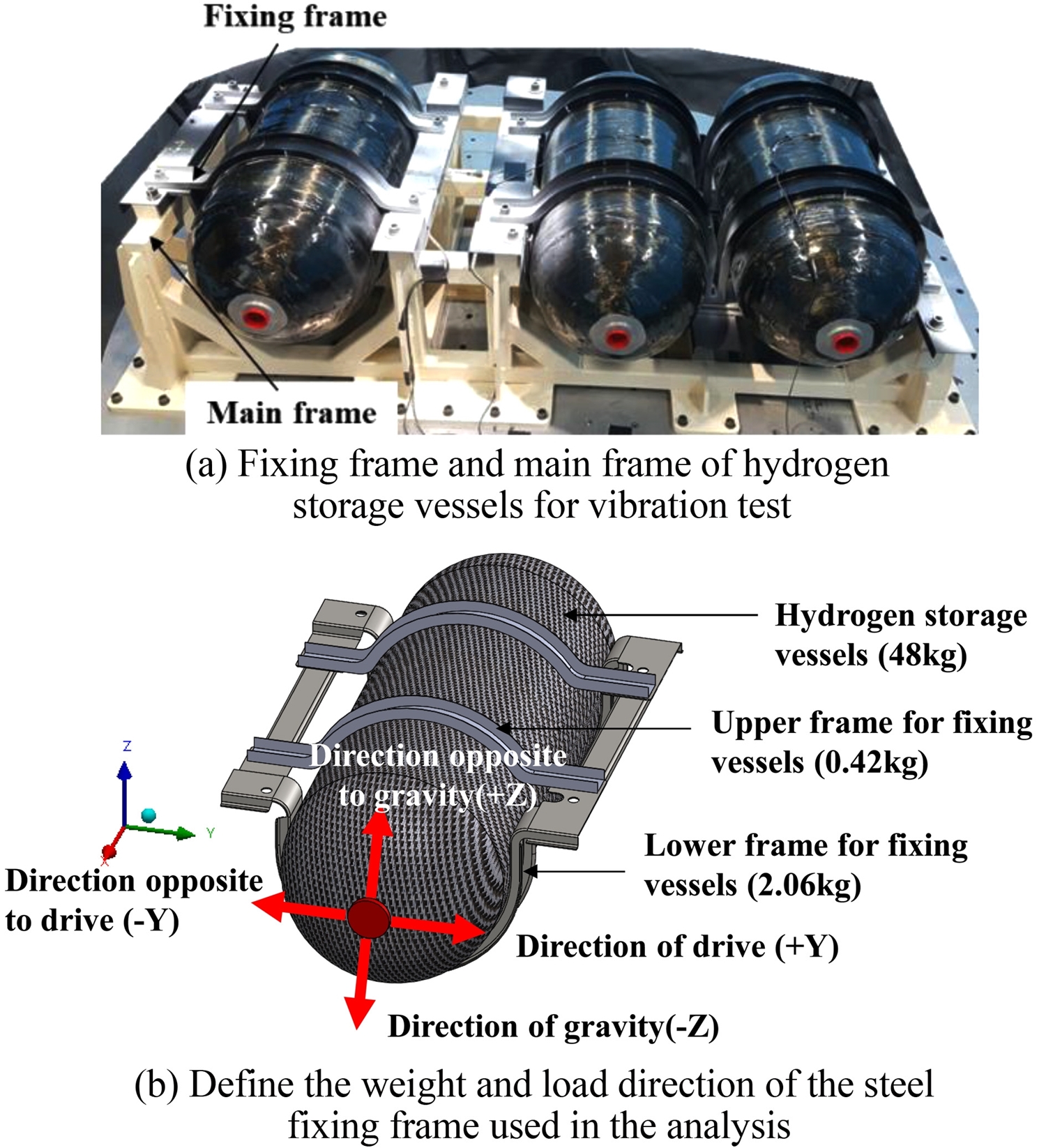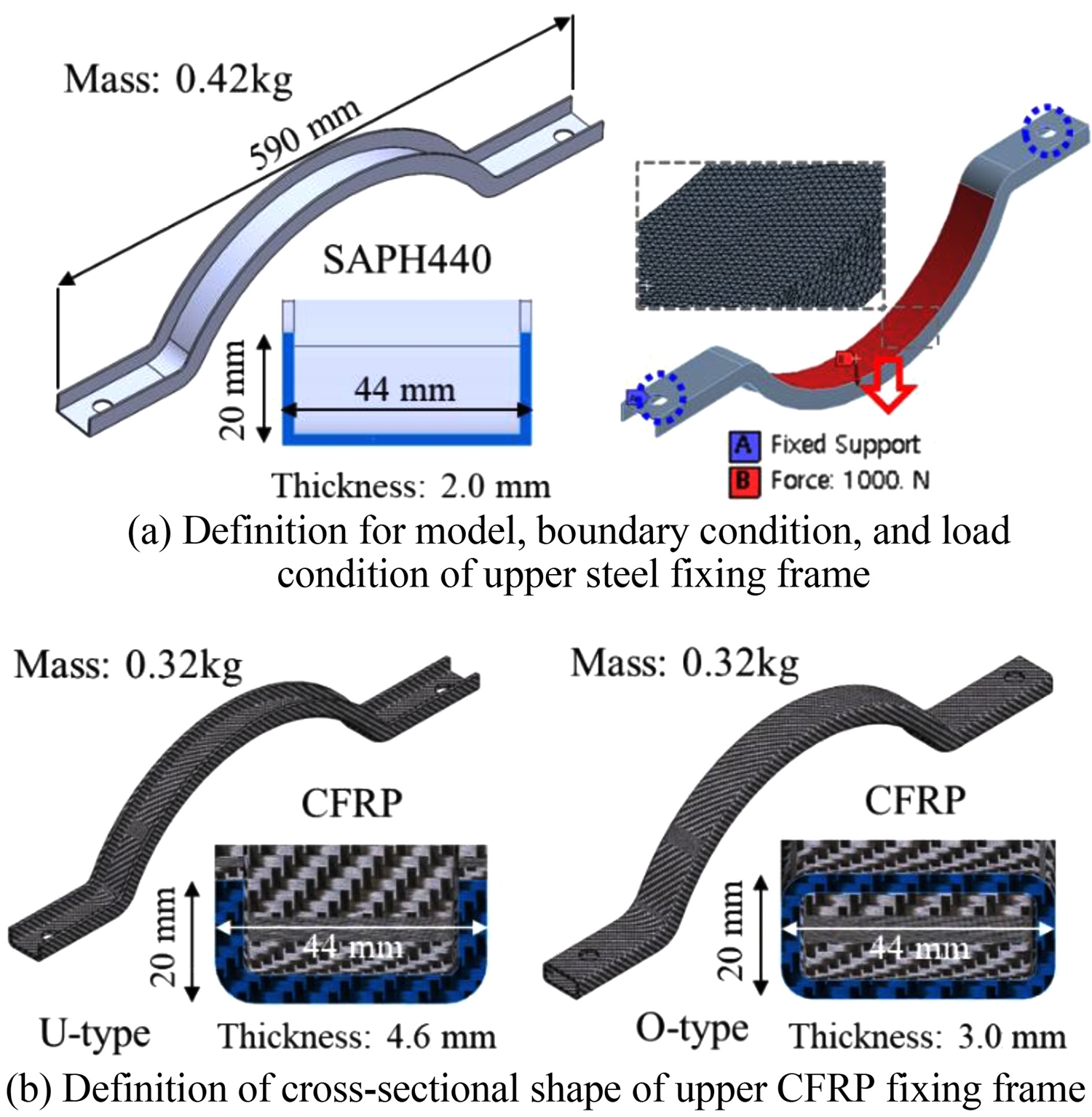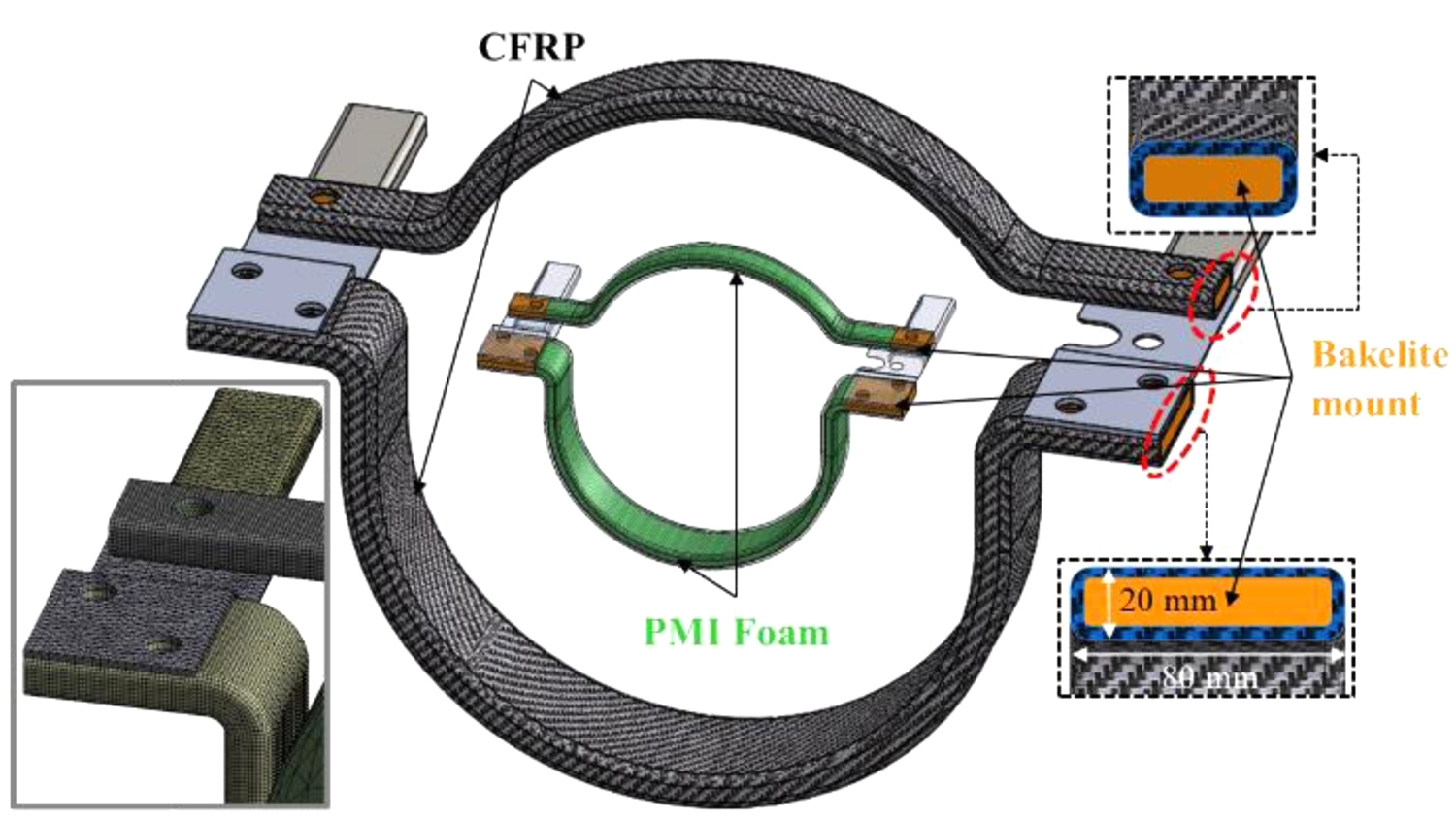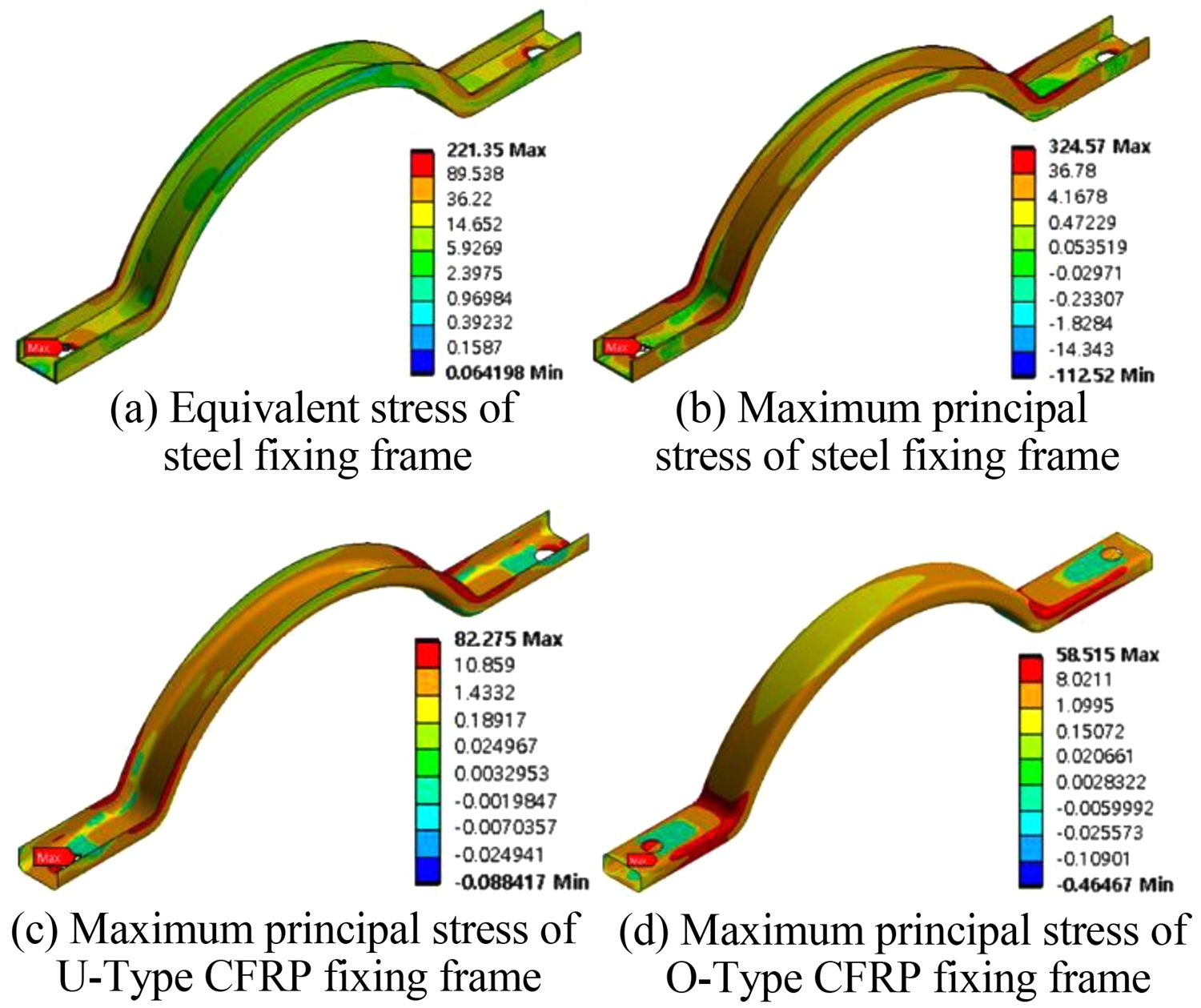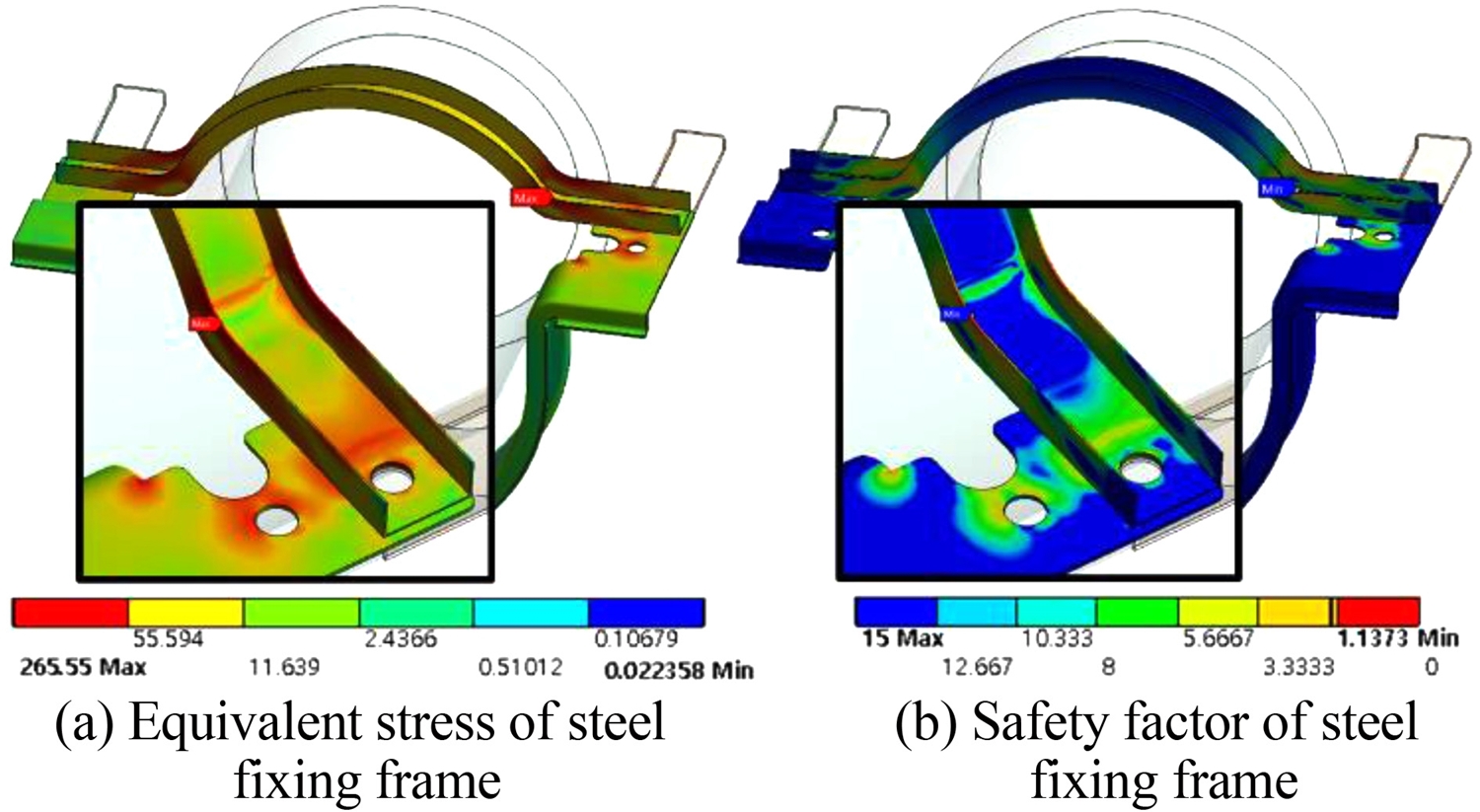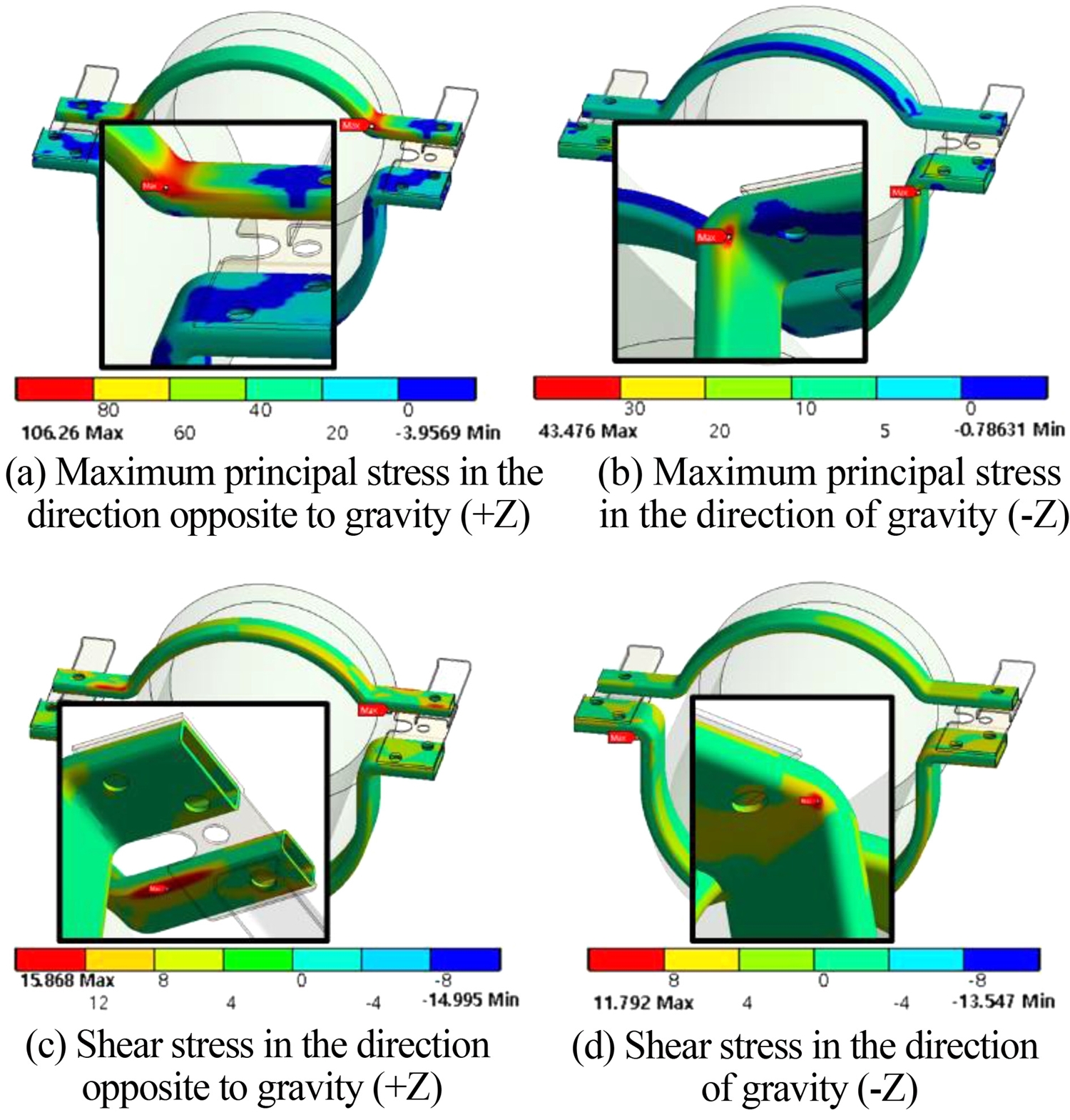
폼코어 CFRP 샌드위치 복합재를 적용한 수소저장용기 고정 프레임 설계


Copyright © The Korean Society for Precision Engineering
This is an Open-Access article distributed under the terms of the Creative Commons Attribution Non-Commercial License (http://creativecommons.org/licenses/by-nc/3.0) which permits unrestricted non-commercial use, distribution, and reproduction in any medium, provided the original work is properly cited.
Abstract
A fixing frame applied with Foam Cored CFRP Sandwich Composite (FCCSC) that replaces SAPH440 steel used in the fixing frame for hydrogen storage was designed, and its structural safety was evaluated. In the design of the fixing frame, FCCSC was implemented by PMI foam core, a Bakelite mount, and Carbon Fiber Reinforced Plastics (CFRP) using woven carbon fiber prepreg. Unlike the steel fixing frame, the FCCSC-applied fixing frame had a cross-section of hollow-rectangular, and its validity was confirmed through finite element analysis. Structural analysis of the designed FCCSC-applied fixing frame and steel fixing frame was performed. Under the extreme load condition of 9G acceleration, the steel fixing frame showed the lowest safety factor of 1.14 based on the yield strength in the opposite direction of gravity. On the other hand, the FCCSC-applied fixing frame showed a safety factor of 7.6 at the maximum principal stress and 3.15 at the shear stress. Through this result of structural analysis, it was verified that the FCCSC-applied fixing frame, which was 25.8% lighter than the steel fixing frame, was 1.8 times safer.
Keywords:
Hydrogen storage vessels, Fixing frame, Foam cored CFRP sandwich composite, Finite element analysis, Structural safety키워드:
수소저장용기, 고정 프레임, 폼코어 CFRP 샌드위치 복합재, 유한요소해석, 구조 안전성1. 서론
수송기기용 섬유강화 복합재 기술이란 자동차, 철도차량, 해양수송 선박, 항공, 우주산업 분야에 사용되는 모든 종류의 섬유 및 부직포 기반의 복합재를 통칭한다. 수송기기의 내외장재 및 구조재의 경량화를 목적으로 고강도, 고탄성률 및 고내열성 섬유강화복합재의 개발을 위한 고성능 프리프레그(Prepreg), 프리폼(Freeform), 그리고 폼(Foam) 적용 관련 기술개발이 활발히 이루어지고 있다.1-3
수송기기는 내부 동력장치에 의한 내부진동과 이동(주행)에 따른 외부진동을 동시에 받는 것이 일반적이며, 이 두 진동이 합해져 공진이 되면 부품 파손에 이르는 경우가 발생할 수 있다. 따라서 이를 방지하기 위해 수송기기부품에는 내진 특성이 요구된다.4
일반적으로 구조재용 고분자 폼이 중심에 배치되고, 고분자 폼의 한면 또는 양면에 탄소섬유복합재(Carbon Fiber Reinforced Plastics, CFRP), 유리섬유복합재(Glass Fiber Reinforced Plastics, GFRP) 등과 같은 이종소재가 결합되는 폼코어 샌드위치 복합재는 부피 대비 경량 특성과 진동 감쇠 특성이 우수하다.5,6 따라서 수송기기 부품에 요구되는 경량 및 진동 특성을 충족시키기 위해 구조재용 폼을 코어재로 적용한 폼코어 CFRP 샌드위치 복합재(Foam Cored CFRP Sandwich Composite, FCCSC)의 연구를 시작하게 되었다.7-9
본 연구는 현재 수소전기자동차의 수소저장용기 고정 프레임에 사용되고 있는 자동차 고장력 강판(아연도금강판) SAPH440 2.0 t을 대체하는 FCCSC 적용 고정 프레임을 설계하고 구조 안전성을 평가하는 것이다. 이를 위해 코어에는 열경화성 구조재용 폼인 PMI (Polymethacrylimide) 폼을, CFRP에는 평직 탄소섬유 프리프레그를 적용 소재로 선택하였다. 그리고 수소저장용기 고정 프레임의 크기와 형상은 기존 강판 고정 프레임을 인용하였다. FCCSC의 성능 구현을 위해 유한요소해석을 통해 고정 프레임의 단면 설계를 진행하였고, 그 단면을 적용한 고정 프레임의 구조해석을 수행하였다. 이렇게 얻어진 해석결과를 바탕으로 SAPH440과 FCCSC를 적용한 고정 프레임의 안전성을 비교 평가하였다.
2. 실험방법
2.1 강판 수소저장용기 고정 프레임
SAPH440로 제작된 수소저장용기 프레임은 Figs. 1(a)와 같으며, 본 연구의 대상은 수소저장용기 1개를 단독으로 고정하는 프레임으로 1(b)와 같은 무게를 갖는다. 구조해석에 사용된 SAPH440의 재료물성은 Table 1과 같다.
2.2 강판 고정 프레임의 유한요소해석 모델
본 연구에서 수소저장용기 고정 프레임이 받는 하중 조건은 가속도 9 G (88.2m/s2)로, 방향은 중력 방향(-Z), 중력 역방향(+Z), 차량 주행방향(전면, +Y), 차량 주행 역방향(후면, -Y)으로 각각 나누어 부여하였다.
경계조건은 Fig. 1(a)와 같이 메인 프레임과의 고정된 상태를 반영하였다. 고정 프레임이 메인프레임과 볼트로 결합된 부분은 변형이 없는 것으로 설정하였다. 그리고 나머지 접촉 부분은 선형접촉이론(Linear Contact Theory)을 반영하여 경계조건을 부여하였다. 요소는 솔리드 요소(Solid Element: Tetrahedrons)로 372,283개의 절점(Node)과 189,630개의 요소(Element) 수준으로 분할하였다.
2.3 수소저장용기 고정 프레임의 단면 설계
기존 강판으로 제작된 고정 프레임의 단면은 ‘U’ 형태이다. 이러한 형태는 탄소섬유복합재로 성형하는 것도 어렵지만 탄소섬유의 연속성이 부족하여 기계적 물성에서도 단점으로 작용될 것으로 예측된다. 이에 연속성을 보완한 ‘O’ 형태의 중공 사각 단면과 ‘U’ 형태 단면에서 대해 단면 형상에 따른 변위와 응력을 유한요소해석으로 확인하였다. 사용된 모델은 상부 고정 프레임으로 SAPH440으로 제작된 모델은 0.42 kg, 탄소섬유복합재로 제작된 프레임은 0.32 kg으로 디자인하였다. 이렇게 무게를 낮춘 이유는 진동 특성을 반영할 폼과 연결 마운트 부품이 추가되어야 하기 때문이다.
해석 모델의 요소 크기는 2mm로 강판 고정 프레임은 204,418개의 절점과 107,278개의 요소 수준이다. 이에 반해 CFRP 모델은 쉘 요소(Shell Element)로, ‘U’ 형태는 13,595개, ‘O’ 형태는 20,015개의 요소 수준이다.
사용된 평직 탄소섬유 프리프레그로 제작된 복합재의 물성은 Table 2와 같다. 경계조건은 볼트로 고정되는 부분을 완전 고정하였고, 하중 조건은 수소저장용기와 접촉하는 면에서 중력 반대방향으로 1 kN을 부여하였다.
2.4 FCCSC 적용 수소저장용기 고정 프레임의 구조해석
FCCSC가 적용된 수소저장용기 고정 프레임의 구조해석을 수행하였다. 단면 형상은 앞의 2.3절에서 언급한 중공 사각 단면 형상을 적용하였다. 적용된 단면 형상에 PMI 폼을 삽입하여 진동특성을 부여하였다. 그리고 고정 프레임이 메인 프레임과 볼트로 결합되는 부분에는 볼트의 압축을 견디기 위해 베이클라이트(Bakelite)로 제작한 마운트를 삽입하였다. 이 마운트는 폼과 접합한 후에 평직 탄소섬유 프리프레그로 감싸지게 된다. 이때 상부 고정 프레임은 0.5 mm 두께를 갖는 평직 프리프레그를 0°로 6층 적층하고, 하부 고정 프레임은 0°로 8층을 적층하는 것으로 Fig. 3과 같이 설계하였다. 이때 상부 고정 프레임의 질량은 446 g (CFRP 349, PMI Foam 33, Bakelite Mount 64 g)이고, 하부고정 프레임은 1,395 g (CFRP 1,100, PMI Foam 89, Bakelite Mount 206 g)이다.
유한요소해석에 적용된 베이클라이트와 PMI 폼의 재료물성은 Table 3과 같다. 경계조건과 하중 조건은 앞 2.2절에서 언급한 강판 고정 프레임 해석과 동일하다. 그리고 요소분할에서 요소는 솔리드 요소와 쉘 요소를 함께 사용하여 1,166,193개의 절점과 408,180개의 요소 수준으로 분할하였다.
3. 결과 및 고찰
3.1 수소저장용기 고정 프레임의 단면 설계
강판 고정 프레임의 최대 변형량(Deformation)은 0.266mm이고, 최대 등가응력(von-Mises Stress)은 Fig. 4(a)와 같이 221.35 MPa로 해석되었다. 이를 탄소섬유복합재의 시편과 비교하기 위해 탄소섬유복합재 파손을 판단하는 최대주응력(Max. Principal Stress)을 보면 Fig. 4(b)와 같이 324.57 MPa이 산출되었다.
이에 반해 탄소섬유복합재로 제작된 U-Type 상부 고정 프레임의 최대주응력은 Figs. 4(c)와 같이 82.28 MPa이었고, O-Type 상부 고정 프레임은 4(d)와 같이 58.52 MPa이었다.
Table 4와 같이 강판 고정 프레임의 최대주응력을 기준으로 U-Type 상부 고정 프레임은 74.6, O-Type 상부 고정 프레임은 82.2% 낮은 최대주응력을 보였다. 탄소섬유복합재 시편들의 비교에서는 U-Type 상부 고정 프레임보다 O-Type 상부 고정 프레임이 28.9% 더 낮은 최대주응력을 보였다. 이를 통해 고정 프레임의 단면에 사각 중공 단면을 적용하는 것이 타당하다는 것을 확인할 수 있었다.
3.2 수소저장용기 고정 프레임의 구조해석
강판 고정 프레임의 구조해석 결과는 Table 5와 Fig. 5와 같다. 하중 조건에서 주행 방향과 주행 역방향 하중에 따른 해석 결과는 비슷한 결과를 보였다. 이는 원점에서 Y축 방향으로 거의 비슷한 형태를 보이고 있어 대칭적인 결과를 보인 것으로 사료된다. 이에 반해 중력 방향과 반중력 방향의 하중에서는 고정 프레임의 단면적 크기가 33.3% 차이를 보이면서 최대변형량은 80, 최대등가응력은 11%의 차이를 보였다. SAPH440의 항복강도(Yield Strength) 302 MPa를 기준으로 안전계수를 확인한 결과 중력 방향인 +Z 방향에서 제일 낮은 1.14를 보였다. 하지만 극한강도(Ultimate Strength) 440 MPa를 기준으로 안전계수를 산출하면 1.66으로 항복강도 안전계수에 비해 46% 증가한다.
FCCSC를 적용한 고정 프레임의 구조해석 결과는 Table 6 및 Fig. 6과 같다. 강판 고정 프레임의 구조해석 결과 경향과 동일하게 주행 방향과 주행 역방향의 해석 결과가 비슷하였다. 그리고 상부 고정 프레임의 CFRP 단면적은 하부 고정 프레임의 45.5%이면서 최대변형량은 하부 고정 프레임보다 3.1배 높은 0.453mm를 보였고, 최대주응력에서는 1.4배 높은 106.26 MPa를 보였다. 이는 CFRP의 허용 응력 한계인 805 MPa를 기준으로 7.6의 안전계수를 갖는 낮은 응력이다. 이와 함께 전단응력의 최댓값은 15.87 MPa로 허용 응력 한계인 50 MPa를 기준으로 3.15의 안전계수를 보였다. 이는 파손기준으로 3배의 안전함을 나타내는 수치이다. 하지만 최대주응력 대비 낮은 안전계수이다. 이를 해결하기 위해서는 평직 탄소섬유 프리프레그의 적층을 0°로만 적용하지 말고 45°를 적용한 층을 부여하여 최대주응력과 전단응력 사이의 균형을 맞추는 것이 필요하다.
4. 결론
본 연구에서는 수소저장용기 고정 프레임에 사용되고 있는 강판 SAPH440 고정 프레임을 대체하는 FCCSC 적용 고정 프레임을 설계하고 구조 안전성을 평가하였다.
고정 프레임의 설계에서 구조재용 폼인 PMI 폼과 베이클라이트 마운트, 그리고 평직 탄소섬유 프리프레그를 사용한 CFRP를 선택하여 FCCSC를 구현하였다. 고정 프레임의 단면은 강판 프레임과 달리 사각 중공 단면을 적용하였고, 중공 사각 단면 적용의 타당성은 유한요소해석을 통해 확인하였다.
설계된 FCCSC 적용 고정 프레임과 강판 고정 프레임의 구조 해석을 수행하였다. 9 G 가속도라는 극한 하중 조건에서 강판 고정 프레임은 중력 역방향인 +Z 방향 하중 조건에서 항복강도 기준 1.14라는 최저 안전계수를 보였다. 이에 반해 FCCSC 적용 고정 프레임은 최대주응력에서는 7.6, 전단응력에서는 3.15의 최저 안전계수를 보였다. 이를 통해 강판 고정 프레임보다 25.8% 경량화된 FCCSC 적용 고정 프레임이 1.8배 더 안전한 것으로 분석되었다. 하지만 이는 최적의 프리프레그 적층 각도를 산출하여 적용할 경우 강판 고정 프레임과의 안전성은 더 많은 차이를 보일 것으로 사료된다.
다음 연구에서는 강판 고정 프레임과 FCCSC 적용 고정 프레임과의 진동 특성을 유한요소해석을 통해 분석하고, 실제 제작한 고정 프레임으로 진동 시험을 통해 분석 결과를 확인할 예정이다.
Acknowledgments
이 논문은 한국생산기술연구원 기관고유사업 KITECH JA-190019 연구비 지원으로 수행된 연구 결과임.
REFERENCES
-
Gao, T., Park, J. W., and Cho, J. U., “A Study on Fracture Behavior at the Composite Plates of CFRP and Aluminum Bonded with Sandwich Type,” International Journal of Precision Engineering and Manufacturing, Vol. 18, No. 11, pp. 1547-1552, 2017.
[https://doi.org/10.1007/s12541-017-0183-4]

-
Bang, S.-O. and Cho, J.-U., “A Study on the Compression Property of Sandwich Composite with Porous Core,” International Journal of Precision Engineering and Manufacturing, Vol. 16, No. 6, pp. 1117-1122, 2015.
[https://doi.org/10.1007/s12541-015-0144-8]

-
Lyu, M.-Y. and Choi, T. G., “Research Trends in Polymer Materials for Use in Lightweight Vehicles,” International Journal of Precision Engineering and Manufacturing, Vol. 16, No. 1, pp. 213-220, 2015.
[https://doi.org/10.1007/s12541-015-0029-x]

-
Kim, J.-S., Lee, W.-G., Kim, I.-K., and Yoon, H.-J., “Natural Frequency Evaluation of a Lightweight GFRP Composite Bogie Frame,” International Journal of Precision Engineering and Manufacturing, Vol. 16, No. 1, pp. 105-111, 2015.
[https://doi.org/10.1007/s12541-015-0013-5]

-
Flores-Johnson, E. and Li, Q., “Experimental Study of the Indentation of Sandwich Panels with Carbon Fibre-Reinforced Polymer Face Sheets and Polymeric Foam Core,” Composites Part B: Engineering, Vol. 42, No. 5, pp. 1212-1219, 2011.
[https://doi.org/10.1016/j.compositesb.2011.02.013]

-
George, T., Deshpande, V. S., Sharp, K., and Wadley, H. N., “Hybrid Core Carbon Fiber Composite Sandwich Panels: Fabrication and Mechanical Response,” Composite Structures, Vol. 108, pp. 696-710, 2014.
[https://doi.org/10.1016/j.compstruct.2013.10.002]

-
Lee, J.-C., Park, D.-H., Jung, H.-S., Lee, S.H., Jeong, W. Y., et al., “Design for Carbon Fiber Lamination of PMI Foam Cored CFRP Sandwich Composite Applied to Automotive Rear Spoiler,” Fibers and Polymers, Vol. 21, No. 1, pp. 156-161, 2020.
[https://doi.org/10.1007/s12221-020-9489-4]

-
Lee, J.-C., Yu, S., Jung, H.-S., Kim, K.-Y., and Lim, D. Y., “Measurement of Interfacial Bonding Force between Foam and CFRP in Foam-Cored CFRP Sandwich Composites,” Fibers and Polymers, Vol. 22, No. 7, pp. 1-6, 2021.
[https://doi.org/10.1007/s12221-021-0236-2]

-
Cheon, S., Yu, S., Kim, K.-Y., Lim, D. Y., and Lee, J.-C., “Improvement of Interfacial Bonding Force between PMI Foam and CFRP in PMI Foam-Cored CFRP Sandwich Composites,” Fibers and Polymers, Vol. 22, No. 8, pp. 1-4, 2021.
[https://doi.org/10.1007/s12221-021-0792-5]

-
Seo, K.-J., Lee, J.-M., and Choi, B.-H., “Investigation of the Effect of the Roughness-Induced Crack Closure on the Fatigue Crack Propagation Behavior of Hot-Rolled Steels under Mixed-Mode Loading Conditions,” Materials Transactions, Vol. 53, No. 2, pp. 264-269, 2012.
[https://doi.org/10.2320/matertrans.I-M2011839]

- ANSYS, Composite_Materials.xml, Ansys Inc.
- MatWeb, “Sumitomo Bakelite Durez® 118 Phenolic, Compression Grade,” http://www.matweb.com/search/DataSheet.aspx?MatGUID=9ea394ae46b94ea0a357cd2fa7d5dfa0, (Accessed 22 DECEMBER 2021)
- MatWeb, “Evonik Rohacell® 110 Hero Aircraft Grade Polymethacrylimide (PMI) Foam,” http://www.matweb.com/search/DataSheet.aspx?MatGUID=0b5186d95cd34e26a90e7d0c479179dd&ckck=1, (Accessed 22 DECEMBER 2021)

Senior Researcher in the Material and Component Convergence R&D Department, Korea Institute of Industrial Technology (KITECH). His research interests are carbon material, composites, and numerical analysis.
E-mail: jc2@kitech.re.kr
